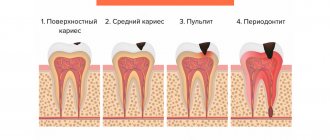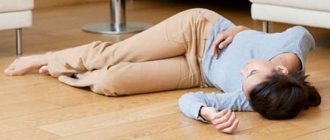Physiotherapy for osteochondrosis
Treatment of osteochondrosis with physiotherapy is a fairly effective measure, and most importantly, it is painless and has virtually no contraindications. Such procedures help relieve inflammation, eliminate spasms, and eliminate pinched nerve endings. Physiotherapy includes procedures such as:
- • Electrophoresis
- • Magnetotherapy
- • Light therapy
- • Shock wave therapy
- • Mud therapy
It is worth knowing that some physiotherapeutic procedures cannot be used during periods of exacerbation. Treatment of osteochondrosis with physiotherapy is prescribed exclusively by a doctor and in combination with drug treatment.
Therapeutic exercise and massage for osteochondrosis
Physical therapy for osteochondrosis helps to form a muscle corset that will help support the diseased spine. A set of exercises is selected individually for each patient individually. For stage 3, exercises are performed only while lying down, smoothly and preferably under supervision.
Treatment of osteochondrosis with massage is also a common practice. The main thing is that the massage is done by a professional who will not harm your spine. After the session, you should feel muscle relaxation, tension removal and general relief. Manual massage helps improve blood circulation. During acute periods of the disease, it is better to abandon this method of treatment.
Treatment of cervical osteochondrosis
With osteochondrosis of the cervical spine, the patient feels severe pain in the head, neck, arms and shoulder girdle. There may be flickering “fly spots”, ringing in the ears and spots before the eyes. As a rule, in the first stages, the patient goes to have his head examined and does not suspect that the matter is completely different. For cervical osteochondrosis, prescribed
- • Agnioprotectors against dizziness, which most often appears in the morning (Trental, Pentilin).
- • Chondroprotectors, which prevent further destruction of cartilage tissue, reduce inflammation, relieve pain and restore joint mobility (Artracam, Artradol).
- • Antidepressants, which patients sometimes have to resort to because constant pain has a detrimental effect on the psyche and contributes to the development of insomnia and depression (Novo-Passit, Donormil).
- • Vitamins that will improve the general condition of the body.
- • Anticolvusants for headaches that interfere with the full life of patients.
- • NSAIDs are prescribed in the acute period to relieve pain.
Diagnosis of cervical osteochondrosis
osteochondrosis of the cervical spine
spine - a disease that causes the intervertebral discs to become thinner and replaced by bone tissue. Men and women over 30 years of age are at risk. It is especially recommended to take a test for cervical osteochondrosis for those who are mainly sedentary.
Cervical osteochondrosis is one of the most common, since this part of the spine is characterized by high mobility and heavy loads. In addition, it is cervical osteochondrosis that is more severe than others, because most of the main vessels, arteries and nerves that carry oxygen to the brain are located in this area. This can lead to a lack of blood circulation in the brain. Therefore, the earlier the disease is diagnosed, the better.
The main symptoms of cervical osteochondrosis
Cervical osteochondrosis is diagnosed by several symptoms, recognizing which you can independently make a preliminary diagnosis:
- discomfort and crunching in the neck when turning;
- frequent dizziness and headaches;
- ringing or noise in the ears;
- numbness of the face and neck;
- pain when suddenly moving the head or while sleeping on an uncomfortable pillow;
- feeling of weakness in the arms;
- lack of coordination;
- deteriorating vision and hearing.
These symptoms may indicate not only problems with the cervical spine, but also a number of other diseases. Therefore, for an accurate diagnosis, it is necessary to consult a specialist who will conduct the necessary research, or undergo a detailed test.
In addition, osteochondrosis is a chronic disease, and symptoms may vary depending on the stage of development of the pathology.
Test for cervical osteochondrosis
To get true results, please read carefully and answer these questions honestly:
- Do you experience dizziness?
- Do you often experience headaches?
- Have you had any injuries or damage to the cervical spine?
- Do you experience discomfort when moving your head?
- Do you feel more pain in your neck after sleeping?
- Have you noticed numbness, weakness, or tingling in your limbs?
- Do you experience pain when throwing your head back?
- Do you feel discomfort in your shoulders?
- Do you have difficulty turning your head?
- Does a crunching sound occur when you move your neck?
- Do you have difficulty moving your neck?
- Have you ever woken up with neck pain?
- Does constant or paroxysmal pain appear when turning and tilting the head, as well as at rest?
Range of motion for a healthy cervical spine (for correct answers to test questions):
- bending – 45 degrees;
- extension – 50 degrees;
- tilts to the sides - 45 degrees;
- twist – 75 degrees.
Affirmative answers to more than 2 questions from this list indicate possible cervical osteochondrosis. In this case, it is imperative to contact a specialist. Only a doctor can accurately determine the cause of discomfort, prescribe an effective treatment plan and draw up a list of recommendations.
If you also answered yes to one or two questions, then you should adhere to the following recommendations:
- When lifting heavy objects, do not tilt your head forward;
- do not sleep on high pillows;
- do not keep your head thrown back for a long time;
- do not bend over while writing or reading;
- Do not turn your head from side to side too sharply.
In addition to answering the questions, you can do several exercises. If pain is felt or a crunch occurs during their execution, this indicates pathology. Be careful and take your time when performing the following exercises:
- slowly tilt your head towards your chest and touch your chin to it;
- lower your head to the right and left shoulder, trying to touch it with your ear;
- turn your head right and left at right angles;
- gently turn your head to the sides all the way, trying to look behind your back;
- gently tilt your head back, looking up and slightly back;
- sit down, tilt your head back, clasp your hands and press down, placing them on the top of your head.
Diagnosis of cervical osteochondrosis
For a more accurate diagnosis of the disease, you can consult a doctor. In this case, the specialist will conduct a test, examine the patient, determining areas of pain and the degree of mobility of the ridge, in order to assess the quality of reflexes.
In addition, for diagnosis, the doctor may prescribe radiography, multislice computed tomography, magnetic resonance imaging or duplex scanning of the arteries of the head and neck.
Complications of cervical osteochondrosis
If you do not treat the pathology and start its development in the initial stages, then the following consequences may occur:
- vertebral artery syndrome (deterioration of vision and hearing, frequent fainting);
- serious neurological disorders (muscle atrophy, paralysis, impotence, loss of sensitivity);
- loss of ability to work.
In particularly critical cases, surgery cannot be avoided.
Prevention of pathology
To prevent the development of the disease, you should follow some rules. Their observance is also necessary for those who have undergone a course of treatment for cervical osteochondrosis (both surgical and conservative), because any treatment only slows down or stops the development of the pathology, and does not completely cure. Adhere to the following preventive measures:
- lead a healthy and active lifestyle;
- visit the pool;
- eat right;
- do not lift heavy objects;
- engage in physical therapy (with your doctor’s permission);
- purchase a high-quality orthopedic mattress and pillow;
- be careful when moving your neck.
Author: K.M.N., Academician of the Russian Academy of Medical Sciences M.A. Bobyr
Treatment of thoracic osteochondrosis
With osteochondrosis of the thoracic spine, sharp pain is observed in the front of the chest, and breathing can become frequent and heavy. Sharp pain may occur when turning and bending in the area of the shoulder blades. It is difficult to diagnose thoracic osteochondrosis, since pain is not felt directly in the spine, and the symptoms are more similar to diseases of the heart, lungs or kidneys. Fortunately, this type of osteochondrosis is very rare and is caused in most cases by scoliosis.
Possible consequences
In the absence of proper treatment for a long time, osteochondrosis continues to progress, leading to serious complications. Thus, damage to the lumbar region can cause the formation of intervertebral hernias, the development of sciatica and lumbar syndrome. With sciatica, the sciatic nerve is pinched or inflamed, and the person experiences a burning, stabbing or shooting pain, usually radiating to the buttocks, thigh or lower leg. Lumbago syndrome is characterized by “lumbago” - powerful spasms in the lumbar area, during which a person is often not even able to move.
Osteochondrosis of the thoracic region is dangerous due to the risk of developing intercostal neuralgia (tokaralgia). Chest pain can be constant or intermittent, occurring only during physical activity or at rest. Sometimes the pain radiates to the arm and neighboring areas of the body. In addition, the patient may be bothered by muscle tension, which causes difficulty breathing and discomfort when coughing. With cervical osteochondrosis, neurological complications such as cervicago (“lumbago in the neck”) and cervicalgia (rather intense chronic pain, accompanied by muscle tightness) develop.
One of the most dangerous consequences of osteochondrosis is spinal stroke. Even with timely medical intervention, acute circulatory disorders in the spinal cord can lead to dangerous complications in the future. With extensive damage, there may be a complete loss of pain and temperature sensitivity in the areas innervated by the damaged area, lameness, partial or complete paralysis of the body. In some cases, pelvic function disorders develop (urinary and fecal incontinence, impotence). Due to the massive death of neurons, even after rehabilitation, lost functions may not be fully restored. Often, a spinal stroke causes disability: for example, musicians or massage therapists who have lost tactile sensitivity can no longer work normally. Movement disorders are characterized by paresis (significant decrease in muscle strength, lethargy) and over time lead to muscle atrophy.
Treatment of lumbar osteochondrosis
Lumbar osteochondrosis is the most common type at the present time. This is due to the fact that it is this part of the spine that is subjected to the greatest loads. First, a dull pain appears in the lumbar region, then the pain begins to radiate to the leg and can lead to numbness of the lower extremities. There are problems with flexion and extension. In such cases, the main thing is to begin timely treatment of lumbar osteochondrosis and apply comprehensive measures. Several rules should be followed:
- • Limit physical activity
- • Take all prescribed medications
- • Take prescribed physical therapy
- • Take a course of special massages
- • If necessary, lose excess weight
If treatment is incorrect and recommendations are not followed, surgical intervention may be required for the last lumbar osteochondrosis.
Causes of osteochondrosis
The causes of osteochondrosis are quite varied.
Firstly, with age, the elasticity of the intervertebral discs is gradually lost.
This means that our back requires special attention. Prolonged stay in a position that causes spinal misalignment can cause irreversible changes. You should avoid sitting in an asymmetrical position, fight the habit of lying on only one side, and carrying a load (for example, a bag) in only one hand.
A sedentary lifestyle has a detrimental effect on the health of the spine. It is necessary to move, but physical activity should be moderate. The spine should be given the opportunity to recover after stress, and it is also advisable to avoid injuries that also lead to the development of spinal pathologies.
The second group of reasons is associated with metabolic disorders
and
poor nutrition
. Food rich in carbohydrates and fats saturates the body with calories, which we, in our sedentary city life, often simply have nowhere to spend; As a result, energy is stored as fat tissue, creating excess weight. Obesity is an increased load on the spine, which leads to the development of osteochondrosis. In addition, such a diet usually contains insufficient amounts of microelements (calcium, potassium, phosphorus, magnesium, manganese and others), which are so necessary to strengthen bone tissue. Endocrine diseases are often the cause of excess weight. At the same time, a violation of energy, water or mineral metabolism can also negatively affect the tissues involved in the structure of the spine.
Factors contributing to the development of osteochondrosis may be:
- flat feet;
- hormonal changes;
- infectious diseases;
- local circulation disorders,
as well as some other factors.
Treatment
Initial treatments for lumbar spine osteochondrosis and pain usually include the following combinations:
- Over-the-counter pain relievers
such as aspirin (Bayer), ibuprofen (Advil), or naproxen (Aleve) can reduce inflammation that contributes to discomfort, stiffness, and irritation of the nerve roots. - Prescription pain medications
. For severe pain, muscle relaxants or narcotic painkillers may be prescribed. These drugs are usually used to treat intense, sharp pain that is not expected to last more than a few days or weeks. These medications can be addictive and cause serious side effects, so they should be used with caution. - Heat and ice
. Applying heat to the lower back improves blood circulation, which reduces muscle spasms and tension and improves mobility. Ice packs can reduce inflammation and relieve mild pain. It is helpful to apply heat before exercise to relax muscles and to apply ice after exercise to minimize inflammation. - Manual therapy.
Manipulation by a specialist is a popular method of pain management for low back pain. Medical practitioners called chiropractors use their hands to manipulate different areas of the body to relieve tension in muscles and joints. Manipulation has been found to be an effective measure for temporarily reducing pain, and in some cases is as effective as drug therapy. - Massage
. Massage techniques can reduce tension and spasms in the muscles of the lower back, reduce pressure on the spine and relieve pain. In addition, therapeutic massage can improve blood circulation, delivering nutrients and oxygen to tight muscles. - Epidural steroid injections
(ESI). Injecting a steroid into the space surrounding the spine can reduce pain impulses as well as inflammation. A steroid injection can be used in conjunction with a physical therapy program to relieve pain during exercise and rehabilitation. Typically, an epidural steroid injection can reduce pain for a period of several weeks to one year.
In many cases, a combination of treatments is necessary for effective pain relief. A process of trial and error is usually necessary to find the treatment that will be most effective.
Prolonged bed rest is not recommended, and immobilization is generally possible for severe pain for a short period of time, as lack of physical activity can weaken the muscles and normal support of the spine.
Lumbar osteochondrosis: symptoms and diagnosis
Treatment of lumbosacral osteochondrosis begins with diagnosis. It is necessary to find out whether this is true osteochondrosis, and what is the extent of tissue damage. Osteochondrosis of the lower back is detected using radiography. The image will clearly show the condition of the intervertebral disc and vertebrae. The doctor clarifies the location of the lesion and assesses the degree of development of the disease. If necessary, an additional MRI or CT may be prescribed to clarify the details.
Diagnosis of osteochondrosis is carried out at the diagnostic center of the Yusupov Hospital, which has everything necessary for an accurate diagnosis. Experienced staff uses modern equipment, which allows them to quickly and correctly identify the patient’s illness. How neurologists and physiotherapists will treat lumbar osteochondrosis will depend on the diagnostic results.
Consequences of spinal osteochondrosis
Osteochondrosis is dangerous due to its complications:
- circulatory disorders, incl. cerebral;
- development of heart attacks and strokes;
- vascular pathologies;
- spinal cord damage;
- hypertension and hypotension;
- stenosis;
- disruption of internal organs and systems;
- mobility restrictions, paresis, paralysis;
- diseases of the pelvic organs (infertility, impotence, incontinence), etc.
In the absence of timely adequate treatment, the death rate from osteochondrosis is about 10%.
Prevention of osteochondrosis
To prevent the development of the disease, you must adhere to the following recommendations:
- keep your weight under control;
- exercise;
- watch your posture, don’t slouch;
- When working at the computer, keep your back straight and periodically do a short warm-up;
- avoid stress;
- give up bad habits;
- sleep on a comfortable bed;
- do not lift weights or lift them slowly, with a straight back;
- wear comfortable shoes;
- eat well.
Do you have back pain and don't know what to do? Come to MedicCity! The clinic has all the necessary modern equipment for expert diagnosis of osteochondrosis. And our neurologists, vertebrologists, chiropractors are true professionals in their field!
Diagnostics.
Most often, the diagnosis of “osteochondrosis” is made by a neurologist. At the initial examination, the doctor conducts an examination in connection with the patient's complaints of pain or limited mobility of the spine. The patient's spine is examined in standing, sitting and lying positions, in states of rest and movement.
Feeling the spine allows you to supplement the examination data (presence or absence of deformation), determine the location, degree and nature of pain. When palpated, tension in the muscles located next to the spine is noted. The patient is asked to bend or squat to determine the range of motion in various parts.
The final diagnosis is made by a neurologist based on a physical examination, as well as the results of radiography, CT or MRI. With the help of these examinations, the level of damage is determined, the diagnosis is specified, and hidden pathologies are revealed. After diagnosis, the attending physician determines treatment tactics and selects the most effective treatment method.
Disease prevention
The best means of preventing osteochondrosis of the lumbar spine are daily gymnastics and a five-minute physical break at the workplace consisting of 6-8 basic exercises, preferably swimming in the pool. All bad habits are eliminated. Particular importance is attached to the choice of mattress. It must be orthopedic, rigid and hard. Meals should be balanced and include more protein foods. The exceptions are fatty foods and mushrooms. Salt consumption is kept to a minimum.
Diagnosis and treatment of osteochondrosis
Diagnosis of spinal osteochondrosis begins with a visit to a neurologist. In this case, the doctor’s qualifications and experience are very important, since similar symptoms can hide various neurological and other diseases.
After collecting anamnesis and examining the patient, hardware diagnostics are performed. Typically the following methods are used:
- ECG;
- radiography;
- MRI;
- CT if necessary.
A set of methods is usually used to treat osteochondrosis:
- treatment with medications (prescription of painkillers and anti-inflammatory drugs, drugs to improve metabolic processes, vitamins, etc.);
- physiotherapy (ultrasound treatment, low frequency currents, laser therapy, magnetic therapy, etc.);
- kinesiotherapy;
- massage, hydromassage;
- manual therapy;
- osteopathy;
- acupuncture;
- traction traction;
- physical therapy and physiotherapy.
Surgical techniques are used in case of ineffectiveness of conservative treatment.
1 Traction traction
2 Acupuncture
3 Osteopathy
Surgery
Surgical treatment of osteochondrosis of the lumbar spine is necessary in cases where conservative treatment for 6 months was ineffective. Surgical treatment for osteochondrosis is always selective, which means that the patient himself decides whether to undergo surgery or not.
It is recommended that all factors be taken into account before deciding to undergo surgery for osteochondrosis, including the length of the recovery period, pain management during recovery, and spinal rehabilitation.
Vertebral fusion surgery
The standard surgical treatment for lumbar spine degenerative disc disease is fusion surgery, in which two vertebrae are fused together. The purpose of fusion surgery (spinal fusion) is to reduce pain and eliminate instability in the motion segment of the spine.
All spinal fusion surgeries consist of the following:
- The damaged disc is completely removed from the intervertebral space (discectomy).
- Stabilization is carried out using bone graft and/or instrumentation (implants, plates, rods and/or screws).
- The vertebrae then fuse to form a solid, immobile structure. Fusion occurs within a few months after the procedure, and not during the operation itself.
After the operation, wearing a corset and taking analgesics are prescribed. Physical exercises are included very carefully, taking into account the individual characteristics of the patient and the degree of tissue regeneration. Full recovery from fusion surgery may take up to a year while the vertebrae fuse together.
Surgical replacement with artificial disc
Replacing a damaged disc with an artificial implant has been developed in recent years as an alternative to fusion surgery. Disc replacement surgery consists of completely removing the disc damaged by degeneration (discectomy), restoring the disc space to its natural height, and implanting an artificial disc.
This procedure is designed to maintain motion in the spine similar to natural motion, reducing the likelihood of increased pressure on adjacent spinal segments (a common complication of spinal fusion).
Recovery from disc replacement surgery usually lasts up to 6 months.
Risk factors
Lifestyle factors that affect overall health can affect intervertebral discs. Risk factors for degenerative disc disease (osteochondrosis) include:
- Family history of back pain or musculoskeletal disorders
- Excessive stress on the lower back due to sports or the nature of work
- Prolonged static loads on the discs due to prolonged sitting and/or poor posture
- Lack of disc support due to weak back muscles
- Obesity
- Smoking or any form of nicotine consumption
Disc degeneration is part of the aging body, but not all people develop pain or any specific symptoms. Symptoms tend to occur when there is instability, muscle tension, and possibly nerve root irritation.









